There are 11 species of turtles in Wisconsin, ranging from the terrestrial Ornate Box turtle to the aquatic Common Snapping turtle. Some of Wisconsin’s native species are unfortunately endangered or threatened. The Ornate Box turtle is one such endangered reptile in Wisconsin.
Throughout this list we’ll explore each of Wisconsin’s native turtle species. This list can be used as a field herping guide or as a way of choosing your next pet turtle. Keep in mind that it may be illegal to possess some of these species in Wisconsin, so it’s always best to research state laws regarding turtle ownership.
Clicking on the name of each turtle will take you to a comprehensive care guide that will help you prepare for owning one of these turtles. After you’ve decided on the species you’d like to get, try and adopt one from an animal shelter first. It’s always better to help these animals out before purchasing brand new animals.
If it’s not possible to adopt from a shelter, then make sure you find a reputable and registered breeder. There are people out there who poach wild animals to sell for quick profits.
Not only is this process illegal in most states, but you could end up with an unhealthy animal. Once a turtle is plucked from the wild and held in captivity, they can stress themselves so badly they suffer severe health problems or perish.
Now, without further ado, let’s dive into the 11 species of turtles in Wisconsin.
Table of Contents
Turtles in Wisconsin
1. Blanding’s Turtle
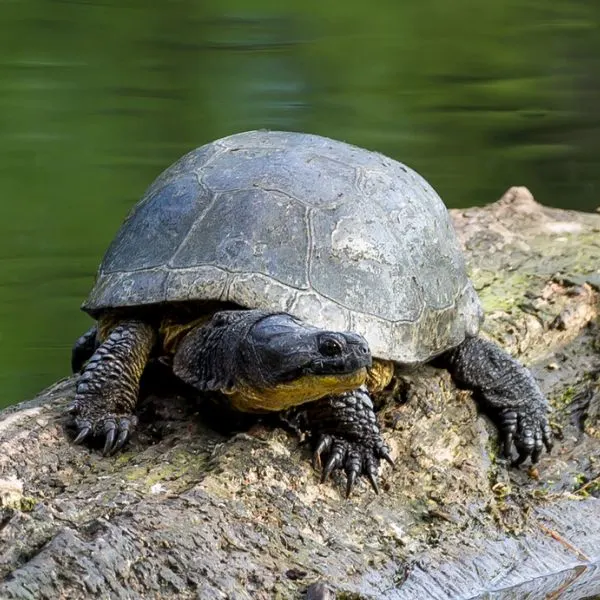
- Experience Level: Intermediate
- Family: Emydidae
- Scientific Name: Emydoidea blandingii
- Other Names: N/A
- Adult Size: 5 to 8 inches (12.5 to 20 cm)
- Lifespan: Up to 80 years
- Average Price Range: $300 to $450
Blanding’s turtles are named after William Blanding, an 18th Century American naturalist. These long-lived semi-aquatic turtles have dark oval shells covered in yellow speckles, with yellow necks and plastrons that have black markings.
These turtles were once listed as threatened, in January of 2014 they were taken off. Still the Blanding’s turtle populations are listed as Special Concern. (Wisconsin Dept of Natural Resources) They are now protected, meaning it’s illegal to move, molest, or take these turtles from the wild. Even though the Blanding’s turtle no longer meets the scientific requirements to be listed as threatened in the state of Wisconsin, they can be found in many areas across the state.
The Blanding’s turtle inhabits many different aquatic habitats and meadows. This turtle is a semi-aquatic turtle that spends a lot of time on dry land.
When they choose a watery hideaway they like to find areas that have a lot of vegetation in the water and on the land to hide in. They can be found in deep waters as well as shallow sedge meadows.
When winter comes they try to find standing water that’s at least three feet deep with a thick, muddy bottom to overwinter.
When they lay eggs, the Blanding’s turtle looks for sandy soils and will often travel long distances to find a suitable spot. Once they have found a good spot, they will return there year after year.
Once babies hatch and eventually reach adulthood, they will return to where they were born to lay eggs. This is why habitat destruction is so hard on their numbers.
These long lived turtles take their time to reach sexual maturity. They don’t start mating until they are nearly 20 years old.
Blanding’s turtles are omnivorous and mainly eat crustaceans such as crayfish. They will also feed on snails, fish, tadpoles, leeches, insects, and earthworms. They will also occasionally eat plant matter.
Box Turtles in Wisconsin
2. Ornate Box Turtle
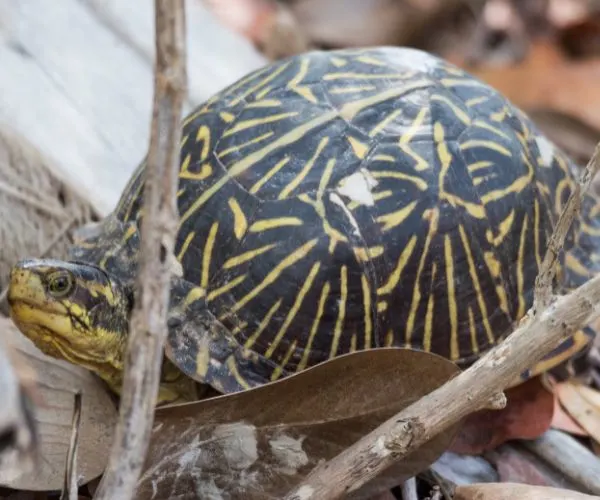
- Experience Level: Intermediate to Expert
- Family: Emydidae
- Scientific Name: Terrapine ornata
- Other Names: Box Tortoise, Western Box Turtle
- Adult Size: 4 to 5 inches (10 to 12.5 cm)
- Lifespan: 30 to 40 years
- Average Price Range: $150 to $450
The Ornate Box turtles is a terrestrial turtle species that inhabits open regions such as grasslands, prairies, and semi-open woodland areas. This species is classified as Endangered in Wisconsin, and can only be encountered in some extreme southern counties.
Ornate Box turtles have distinctive orange to yellow striped patterns across their domed dark brown shells, which makes them a target for the pet trade. People love the beautiful, organic shapes and colors on their shells. They also don’t require watery enclosures which makes this turtle more desirable as a pet.
Habitat loss to roads, agriculture, and development also contribute to their declining numbers. Even certain species of invasive plants are threatening the Ornate Box turtle’s already declining habitat.
Spotted Knapweed and Black Locust are two plants that are crawling across the box turtle’s habitat. The Spotted Knapweed produces toxins in the soil that impedes the growth of native plants. This adaptation must affect Ornate Box turtles as well because they completely avoid areas with this plant.
The Black Locust spreads by sending out shoots and cloning itself. They grow rapidly, and create too much shade for native prairie plants, thus making an unsuitable habitat for the Ornate Box turtle.
Ornate Box turtles are omnivorous, mainly eating insects, such as beetles, caterpillars, and grasshoppers. They will also eat plants, berries, and carrion if they come across any.
Map Turtles in Wisconsin
3. False Map Turtle
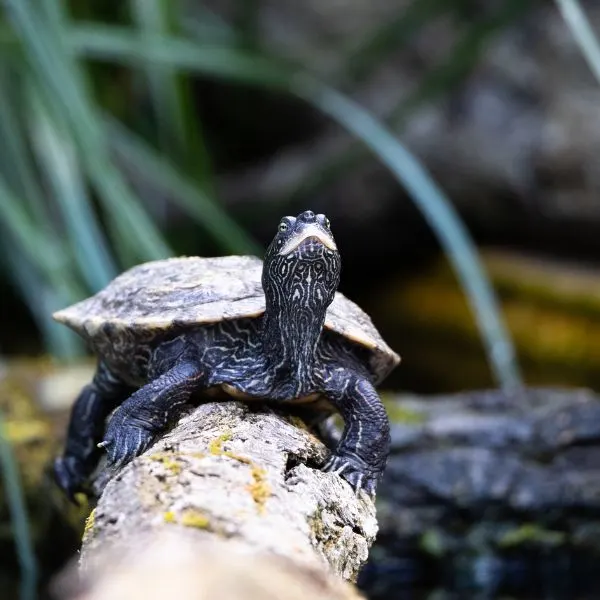
- Experience Level: Beginner
- Family: Emydidae
- Scientific Name: Graptemys pseudogeographica
- Other Names: Sawback turtle
- Adult Size: 3.5 to 10.5 inches (9 to 26.5 cm)
- Lifespan: 30 to 50 years
- Average Price Range: $6 to $40
False Map turtles can be found in Wisconsin’s main river systems and drainages with loose substrates such as gravel or sand. Although they have only been recently classified in Wisconsin, they are thought to be fairly common. This species of turtle has not been tracked and no population numbers exist in Wisconsin.
False Map turtles are difficult to distinguish between other species of Map turtles. One way to help figure out the difference is to look at their plastrons (bottom half of the shell.) False Map turtles’ plastrons are usually not as ornate as other Map turtle species.
This turtle has a dark grey, brown, or green carapace with dark blotches on the scutes. The back of their shell resembles a saw blade, and they have a distinct ridge, or keel across the middle running from front to back.
The reason they are called map turtles is because when they are young, they have light colored markings on their shells that resemble a map. As they get older, these markings start to fade.
False Map turtles are omnivorous and eat aquatic insects, crustaceans, mollusks, and aquatic plants. They also eat fish if they can get them, especially dead fish.
They rarely travel far from the water. Often the only time they leave is to lay their eggs in the spring, or to bask in the sun. They will find floating logs or outcrops and gather to soak in the warming sun.
4. Northern Map Turtle
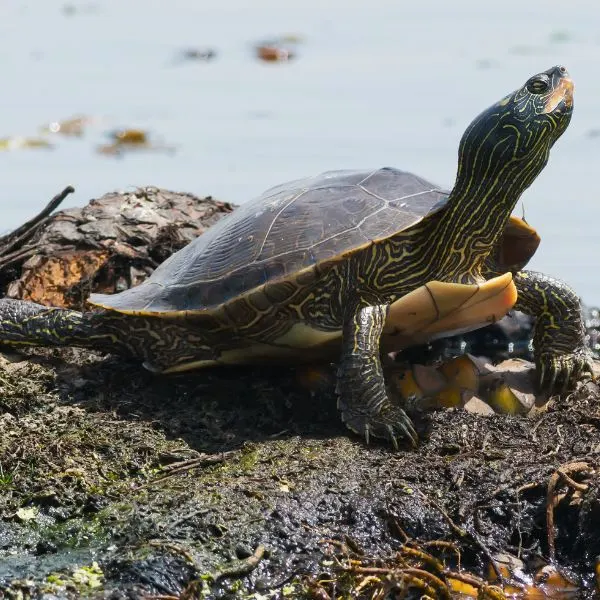
- Experience Level: Beginner
- Family: Emydidae
- Scientific Name: Graptemys geographica
- Other Names: Common Map turtle
- Adult Size: 4 to 10.5 inches (10 to 26.5 cm)
- Lifespan: 15 to 20 years
- Average Price Range: $20 to $60
Northern Map turtles are an aquatic species commonly found in Wisconsin’s major river systems. They prefer a habitat with slow-moving water, soft or muddy bottoms, and a lot of vegetation. These turtles are accomplished swimmers and like to bask above the surface of the water.
Northern Map turtles have dark brown or olive green shells with yellowish markings which resemble the contours of a map. Unlike the false map turtle, this species doesn’t have the thick, pronounced keel running along its back. Small yellow spots behind the eyes also help distinguish the Northern Map turtle from other subspecies.
These turtles are mainly carnivorous, feeding on aquatic insects, crustaceans, small fish, and mollusks. The females of this species have wide heads with strong jaws made for crunching through thick shells.
5. Ouachita Map Turtle

- Experience Level: Beginner
- Family: Emydidae
- Scientific Name: Graptemys ouachitensis
- Other Names: Southern Map turtle
- Adult Size: 3.5 to 10 inches (9 to 25.5 cm)
- Lifespan: 15 to 20 years
- Average Price Range: $40 to $100
Also known as Southern Map turtles, Ouachita Map turtles are relatively common in the swift-moving rivers of Wisconsin’s southern and southwestern regions. They are active during the day and like to bask, but are easily startled and will quickly jump into the safety of the water.
Ouachita Map turtles can be distinguished from other Map turtles by the large lightly colored patches behind their eyes. These Map turtles also have dark patches outlined in yellow contour-like markings on the scutes of their dark brown or olive green shells. Males have a prominent serrated keel protruding from their backs.
As with many other turtles, Ouachita Map turtles are omnivores. They mainly eat crustaceans, insects, dead fish, and mollusks. They will also occasionally eat algae and aquatic plants.
Females get nearly twice as big as males, growing on average to 10 inches long, while the males of the species typically only reach about 6 inches in length.
Musk Turtles in Wisconsin
6. Eastern Musk Turtle
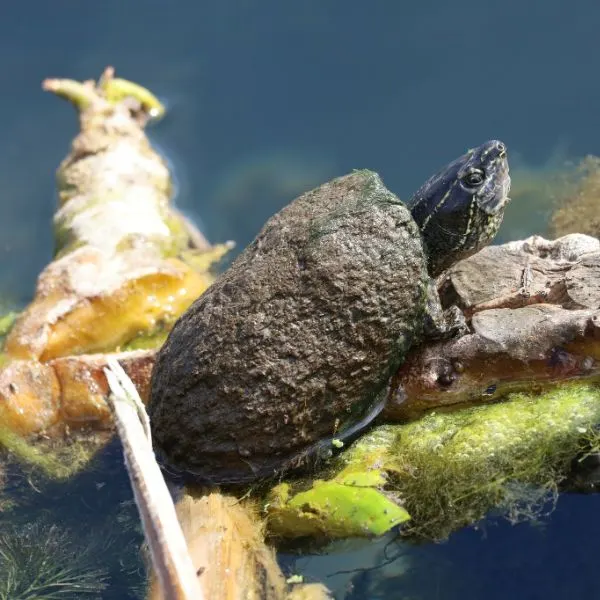
- Experience Level: Intermediate
- Family: Kinosternidae
- Scientific Name: Sternotherus odoratus
- Other Names: Common Musk turtle, Stinkpot
- Adult Size: 4 to 5 inches (10 to 12.5 cm)
- Lifespan: 30 to 50 years
- Average Price Range: $30 to $120
Eastern Musk turtles are commonly known as “Stinkpots” because of the strong odor they can excrete from their musk glands to deter predators. Eastern Musk turtles are one of North America’s smallest aquatic freshwater turtles and need all the protection they can get. They are often found in southeastern parts of Wisconsin.
Eastern Musk turtles have dark brown or black unmarked shells. They have two yellow stripes running down their dark heads as well as fleshy barbels on their chins and necks. This species prefers slow-moving waters in boggy or marshy areas with dense fronds of aquatic vegetation.
They spend most of the time on the bottom of these waters searching for clams and other sources of food. Stinkpot turtles aren’t great swimmers and will often use tall vegetation to climb up to breathe.
Even females rarely bask in the sun. They typically only come out of the water to bask in order to speed up development of their eggs.
These nocturnal omnivores mainly eat small amphibians, crustaceans, and mollusks. They are considered common in Wisconsin.
Painted Turtles in Wisconsin
7.1 Midland Painted Turtle
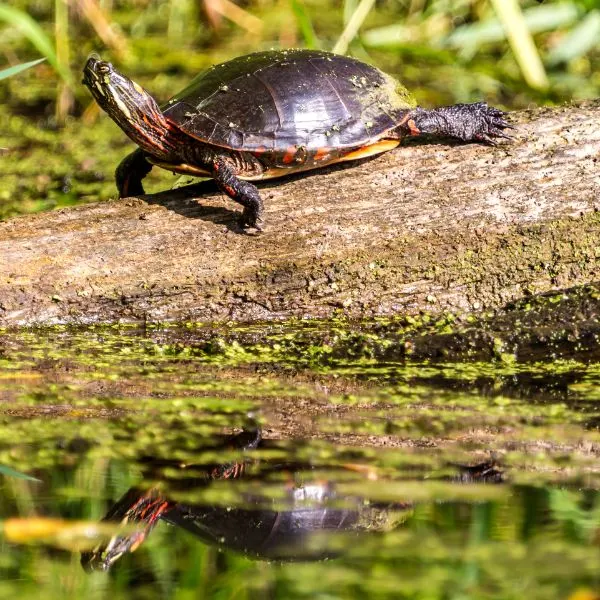
- Experience Level: Beginner
- Family: Emydidae
- Scientific Name: Chrysemys picta marginata (Midland Painted)
- Other Names: N/A
- Adult Size: 4 to 10 inches (10 to 25.5 cm)
- Lifespan: 30 to 50 years
- Average Price Range: $30 to $150
7.2 Western Painted Turtle
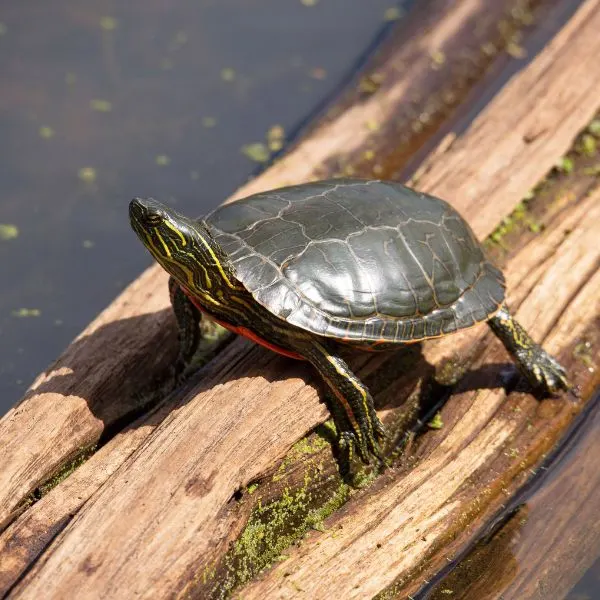
- Experience Level: Beginner
- Family: Emydidae
- Scientific Name: Chrysemys picta bellii (Western Painted)
- Other Names: N/A
- Adult Size: 4 to 10 inches (10 to 25.5 cm)
- Lifespan: 30 to 50 years
- Average Price Range: $30 to $150
There are two subspecies of Painted turtles found in Wisconsin; the Midland Painted turtle and the Western Painted turtle. These two species are some of the most common turtles in Wisconsin. Western Painted turtles tend to inhabit northwestern and western regions of Wisconsin, and Midland Painted turtles found in other areas throughout the state.
Both species have brown skin with yellow striped markings on their faces and necks. Painted turtles have dark brown to black shells that usually have yellow to red coloration around the edge.
Western Painted turtles have plain yellow plastrons, while the slightly larger Midland Painted turtles have red plastrons with a distinct pattern running down the middle.
Each turtle has a different shape. Some have said they look leaf shaped, or like a butterfly. I think of the art projects where you poured paint on a piece of paper, and folded it in half.
These medium-sized aquatic turtles are diurnal and prefer shallow waters such as marshes and ponds and can often be seen basking on logs floating on and sitting beside the water. Both subspecies in Wisconsin are omnivores, consuming small amphibians, insects, mollusks, fish, and vegetation.
Snapping Turtles in Wisconsin
8. Common Snapping Turtle
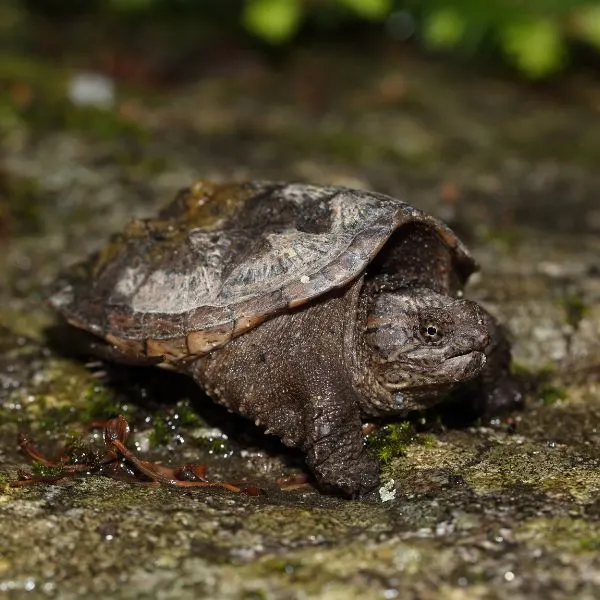
- Experience Level: Intermediate to Expert
- Family: Chelydridae
- Scientific Name: Chelydra serpentina
- Other Names: Common Snapper, Eastern Snapping turtle, Snapper
- Adult Size: 8 to 14 inches (20 to 51 cm)
- Lifespan: 30 to 50 years
- Average Price Range: $20 to $60
Common Snapping turtles are the heaviest species found in Wisconsin and are found in larger bodies of water across the state, such as lakes and reservoirs. Common Snappers are one of top predators in Wisconsin’s freshwater food chain.
Easily identified thanks to their powerful hooked jaws, thick limbs, and heavy shell, Common Snappers have dark brown or green shells with ridges on the carapace. These large turtles have long saw-toothed tails and sharp claws. If captured on land, this species can hiss aggressively and will attempt to bite.
Their plastrons are rather small compared to most other turtles. This is because their limbs are so large. They can’t withdraw into their shells so they put on a show of aggressiveness to scare bigger animals away.
Their bite is strong enough to break bones and do major damage, so if you come across these heavy turtles, just leave them alone.
Common Snapping turtles spend most of their time underwater waiting for food to swim nearby. When it does they shoot their long necks out and snatch up nearly anything they can fit into their mouths.
These big turtles rarely leave the water. When they bask, they prefer to swim up to the surface of the water and hang near the surface to warm up. They will leave the water to find a place to lay eggs or to find another swimming hole.
Common Snapping turtles are nocturnal omnivores that consume amphibians, fish, smaller reptiles and turtles, and even waterfowl. They may also eat vegetation from time to time.
Softshell Turtles in Wisconsin
9. Smooth Softshell Turtle
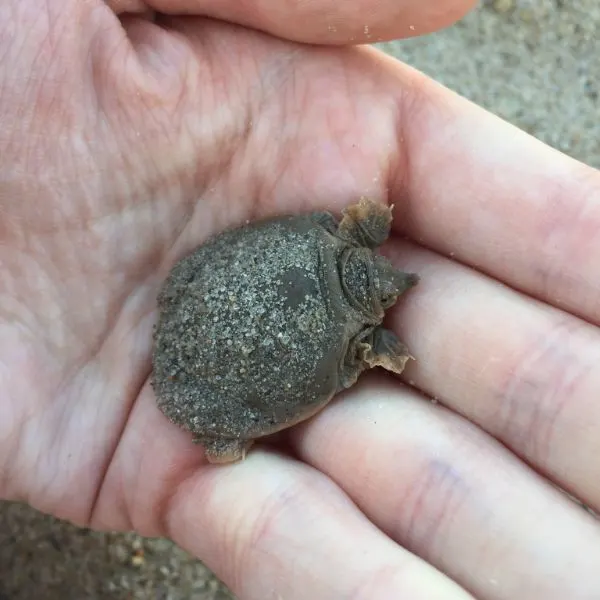
- Experience Level: Intermediate to Expert
- Family: Trionychidae
- Scientific Name: Apalone mutica
- Other Names: Spineless Softshell
- Adult Size: 4.5 to 14 inches (11.5 to 35.5 cm)
- Lifespan: 25+ years
- Average Price Range: $40 to $60
Smooth Softshells are a medium to large species of aquatic turtle that has Special Concern status in Wisconsin. Smooth Softshells are currently found in just a few scattered southwestern counties, where they inhabit very clean rivers with sandy or silty bottoms.
Smooth Softshells resemble leathery pancakes with cream to white plastrons. Their shells are usually brown or gray depending on age. There are very few markings on their carapace aside from a few darker colored spots or blotches.
They have distinctive lines running from behind their eyes. Smooth Softshells have long, tapered snouts which they use as snorkels while waiting to catch prey.
Since they have soft shells, and little protection, these turtles swim quickly and will thrash about with long claws, and a sharp beak when handled. They also have a long neck that can often reach as far back as half the length of their carapace.
These aquatic turtles usually bury themselves in shallow sands to ambush aquatic insects, crustaceans, and mollusks. They are primarily carnivores, eating anything that gets near. They have even been known on occasion to eat small mammals and birds.
Due to the habitat loss of areas with nesting sandbars, Smooth Softshell turtles are in a vulnerable position in Wisconsin. In most other states and regions the smooth softshell turtle numbers appear to be doing well.
10. Spiny Softshell Turtle
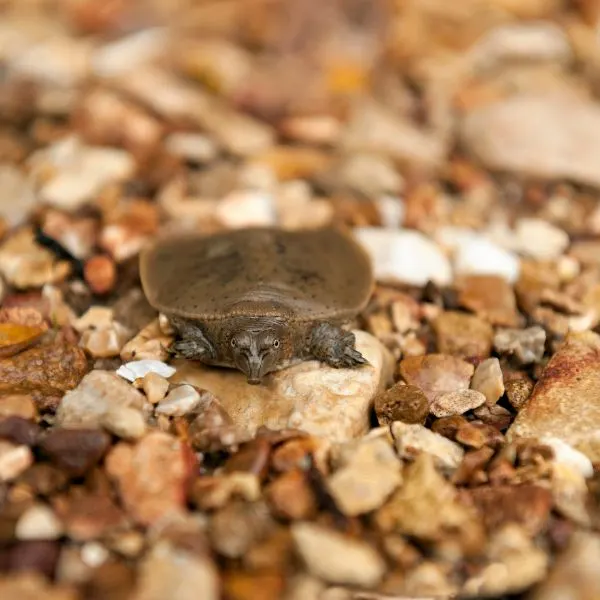
- Experience Level: Intermediate to Expert
- Family: Trionychidae
- Scientific Name: Apalone spinifera
- Other Names: N/A
- Adult Size: 10 to 20 inches (12.5 to 43 cm)
- Lifespan: 20 to 50 years
- Average Price Range: $20 to $120
Spiny Softshells are the most commonly encountered type of Softshell in Wisconsin and can be found across most of the state. They prefer rivers and streams with a faster-moving current and are skilled swimmers.
These softshell turtles are the largest turtles in Wisconsin, and the second largest in the United States. The largest turtle trophy goes to the absolutely massive alligator snapping turtle. Which can reach lengths of 30 inches along its shell, and they can weigh as much as 250 pounds.
Spiny Softshells have leathery pancake-shaped green shells that feel a bit like sandpaper. They differ from the smooth softshell turtle because of the nubs and spikes along the front ridge of their shells.
They also have more pronounced dark spot markings on their soft carapaces. They have long, tapered beaks which they use to breathe while buried in the sand waiting to ambush their prey.
Just like smooth softshell turtles, the spiny versions are carnivores too and will feed on any crustaceans, insects, and mollusks that swim past their hiding place. They then lunge forward to grab the prey in their mouths.
Wood Turtles in Wisconsin
11. Wood Turtle
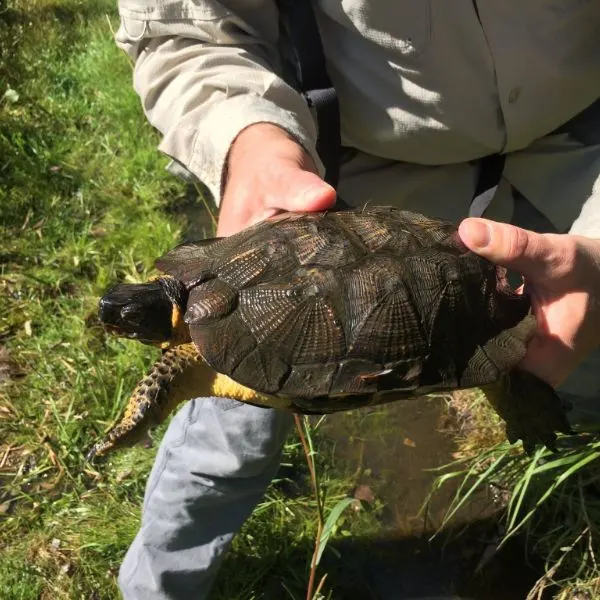
- Experience Level: Intermediate
- Family: Emydidae
- Scientific Name: Glyptemys insculpta
- Other Names: N/A
- Adult Size: 5.5 to 9 inches (14 to 20 cm)
- Lifespan: 40 to 60 years
- Average Price Range: $250 to $500
Wood turtles are an intelligent, partially terrestrial species that inhabits grasslands and woodland areas close to rivers and streams. This species is Threatened in Wisconsin due to habitat loss and unscrupulous activities in the pet trade. That said, they have been recorded as being seen in most areas of the state.
Wood turtles get their name from their dark brown shells, which have a rough, grainy texture and scutes that look as if they have been sculpted from wood. These turtles have markings that appear similar to the growth rings and wood grain of trees. Wood turtles are striking with their unique shells, and bright orange scales.
These diurnal omnivores roam a fair distance each day while looking for berries, earthworms, insects, mollusks, and plants to eat. Wood turtles have been observed doing something call the worm stomp.
Now this might end up being a new viral dance craze because the turtle will stop its feet and shell on the ground. This stomping imitates the sound and vibrations of falling rain or the movement of moles through the ground. This ends up tricking earthworms into emerging from the ground.
The wood turtle then quickly snatches them up and eats them. Another amazing trait of these turtles is how they overwinter. They will find fast moving water and find deep banks or cutouts and spend the winter in the water where they avoid the freezing air.
Frequently Asked Questions about Wisconsin’s turtles
What kind of turtles live in Wisconsin?
Wisconsin is home to 11 species of freshwater turtle, ranging from small aquatic species such as Eastern Musk turtles to larger specimens such as Common Snappers. Most of Wisconsin’s turtles are fairly common, although some species like the Ornate Box turtle and the Wood turtle are classed as Endangered or Threatened.
Where do Box turtles live in Wisconsin?
Ornate Box turtles are the only type of Box turtle native to Wisconsin. These endangered terrestrial turtles inhabit grasslands, prairies, and woodland regions in only a few of Wisconsin’s extreme southern counties;
– Columbia County
– Dane County
– Grant County
– Green County
– Iowa County
– Rock County
– Sauk County
Do Snapping turtles live in Wisconsin?
Common Snapping turtles are Wisconsin’s only native Snapping turtles and are the state’s second largest species. These freshwater turtles can be found in larger bodies of water throughout the entire state and are fully aquatic. They will hiss and bite if captured.
Are Painted turtles native to Wisconsin?
There are two subspecies of Painted turtles that are native to Wisconsin; Midland Painted turtles (Chrysemys picta marginata) and Western Painted turtles (Chrysemys picta bellii). Painted turtles are one of Wisconsin’s most commonly encountered species and can be found across the state. Western Painted turtles are often sighted in northwestern and western counties and Midland Painted turtles in other areas.
Is it illegal to collect turtles in Wisconsin?
Wisconsin has specific laws in place regarding the capture of native turtle species. Capturing Federal or State protected species is illegal. This means that Blanding’s turtles, Ornate Box turtles, and Wood turtles cannot be taken from the wild.
Certain aquatic turtles can be taken in Wisconsin if you possess a Fishing or Small Game license. The season for capturing aquatic turtles extends from mid July to the end of November. Possession limits are in place. You can take 5 specimens of each species except for Spiny Softshells (Apalone spinifera) and Snapping Turtles. You can only take 3 of each of these.
As for owning native Wisconsin turtles as pets, the State protected turtles mentioned above cannot be kept, nor can any Federally protected species. For the remaining species, a possession limit of 5 individuals of each species is in place (3 for Spiny Softshells and snappers).
With all that said, it is illegal to take turtles—even ones you have a license for—to sell them. If you want to get these turtles as pets, it’s best to purchase them from a licensed and checked breeder, or find an adoption agency.
See this page on turtle laws page for more information.
Are Snapping turtles protected in Wisconsin?
Common Snapping turtles are not protected in Wisconsin and can be taken from the wild. However, there are restrictions and limits regarding their capture.
No more than 3 Common Snappers can be taken per season (mid July to end of November), although if fishing on the sections of the Mississippi River that run through Wisconsin, you can take 10 specimens. You must have a Fishing or Small Game license to collect Common Snappers.
A size restriction is also in place for the capture of Common Snappers. You can only take wild Common Snappers that have shells measuring from 12 inches (30.5 cm) to 16 inches (40.5 cm).
What are the biggest turtles in Wisconsin?
The biggest species of turtle found in Wisconsin is the Spiny Softshell turtle (Apalone spinifera) which can reach lengths of up to 20 inches (51 cm). The next biggest species in Wisconsin is the Common Snapping turtle (Chelydra serpentina), which can grow up to 14 inches (43 cm).
Wrapping up
Well that’s the end of our list of the 11 native turtles in Wisconsin. We’ve talked about several turtles in this list, ranging from terrestrial species such as the endangered Ornate Box turtle to commonly encountered aquatic species like the Common Snapper or Painted turtle.
This list is best used as a field guide to help you identify native turtles when out hiking or exploring. You can also use this list to help choose your next pet turtle, and clicking on the name or image of each species will take you to a dedicated care guide.
We hope you enjoyed this list! If you did, don’t hesitate to comment down below and discuss Wisconsin’s native turtles with your fellow turtle lovers.
Other nearby states
